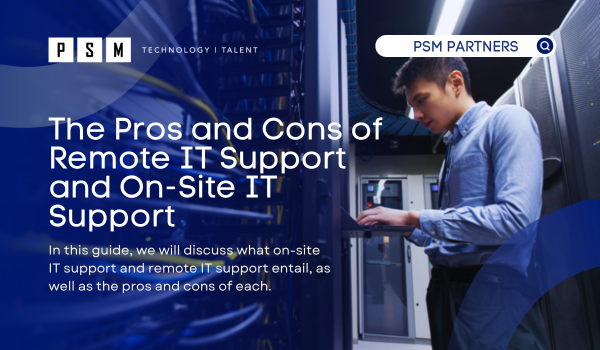Table of Contents
ToggleFew businesses can manage their daily activities without relying on their IT infrastructure. For small and medium-sized businesses especially, they need their IT infrastructure to be efficient to operate their business and they typically do not have the resources for an in-house IT support team. This means that when they face an issue such as corrupted files, security risks, or crashes, they will need the help of a trusted IT professional.
In the past, it was more common for businesses to receive on-site support from an IT professional. Even when businesses hired a third party for managed IT services, these service providers would send a tech to the site to resolve any issues with the IT infrastructure. However, sending a tech for on-site support takes time and may add to the downtime and lost productivity that businesses experience when there is a problem with their IT system.
Since 2020, most companies have shifted to a remote or hybrid work model, so having someone onsite may not even be beneficial for some portion of their user base. Additionally, with many companies adopting a “cloud-first” infrastructure model, there is often less on-premises infrastructure requiring physical hands-on site to manage. More IT service providers are choosing to resolve issues remotely as this saves them the time and effort it takes to get to your office and reduces your downtime as certain issues can be resolved faster. While there are many advantages to remote IT support, there still may be times when on-site IT support is warranted.
In this guide, we will discuss what on-site IT support and remote IT support entail, as well as the pros and cons of each. If your small or medium-sized business could benefit from the help of an IT professional, talk to PSM Partners about our managed IT services.
On-Site IT Support
With on-site IT support, a team of professionals will be on-site at your office to provide tech support. Businesses can get on-site IT support from their own in-house staff or from a third-party provider that sends their staff to your office.
IT professionals that provide on-site support will work one-on-one with businesses and create a sense of consistency and security through face-to-face interaction. They will work to troubleshoot your issues in your presence, which gives you a chance to see what they are doing and ask questions as they go.
Pros of On-Site IT Support
It is important to have a solid business relationship with your IT provider so they can provide the best possible services to maintain your IT infrastructure and implement strategies that are in line with your technology goals. One of the main advantages of on-site IT support is that you will form a stronger professional relationship with your IT provider which will help them gain a deeper understanding of your business.
The more you work with your IT support team face-to-face, the greater grasp they will gain of your business operations and overall IT goals. This will help make their services more efficient and they will be able to help come up with new IT strategies that are in line with your goals.
Cons of On-Site IT Support
There are several disadvantages to on-site IT support that businesses must consider. One possible disadvantage is that small and medium-sized businesses may not have the resources to have their IT professionals handle all the IT work that needs to be done. Troubleshooting and day-to-day maintenance may take up too much time and money and prevent the IT service provider from getting creative with new IT strategies that can improve the infrastructure. There may also be instances where the on-site team does not have the capacity to handle a specific issue.
Another possible disadvantage is that with an on-site team, your business could end up in a situation where just one or two techs have complete access and a thorough knowledge of your system. This is great while you are still working with these techs, but there is also a high turnover rate in the technology industry. If you lose the one tech who knows everything about your IT infrastructure, you will have to start over with a new tech.
Remote IT Support
With remote IT support, managed IT service providers work with businesses from a remote location. They can provide tech support through a high-speed internet connection and communicate with businesses over the phone, through email, or live chat.
For remote IT support to work, you must grant your IT service provider remote access to your IT infrastructure. Once your IT service provider has remote access, they are then able to service end user support requests, as well as the majority of infrastructure alerts and incidents, and use their insight into your environment and business to provide other strategic IT advisory and implementations.
Pro of Remote IT Support
As remote work is becoming more common and businesses migrate additional workloads to the cloud, more businesses are taking advantage of the positive aspects of remote support. One advantage of remote IT support is that businesses have a bigger pool of IT professionals at their disposal with a diverse range of expertise. Businesses that take advantage of remote support are not limited by the capabilities of an on-site team and can find a professional that is knowledgeable on the specific issue where help is needed.
Remote IT support can also save your business time and money. Small and medium sized businesses do not have to hire and pay for an in-house staff and when working with a remote IT service provider, they do not have to pay for the time it takes a tech to travel to their location. Remote support can also result in issues being resolved faster, which drastically reduces downtime and helps keep your business more productive. In many cases, remote IT support is available around the clock so you can resolve issues quickly that occur outside of office hours.
Cons of Remote It Support
The major downside of remote IT support is that businesses have to do their own research to find a service provider that understands the unique needs of your business and acts as a true partner. You should avoid remote IT providers with vague contracts and hidden costs and who lack transparency in their work. Some remote providers may also have slow response times.
| Learn about How to Choose an MSP
Is Remote IT support or Onsite IT Support better?
There are advantages and disadvantages to both on-site and remote IT support that all businesses must consider. If your business prefers to build strong relationships and work with a professional that has a deep familiarity with your business processes and IT infrastructure, on-site IT support may be your preferred option. If you want to draw from a wider pool of IT talent and save time and money with more efficient resolutions, then you should consider remote IT support. It is also important to make sure that you are aware of and understand the possible drawbacks of both approaches when making this decision or consider a hybrid model called co-managed IT.
Managed IT Services from PSM
Regardless of which approach you choose, it is beneficial for small and medium sized businesses to work with a managed IT service provider instead of hiring and maintaining an in-house team. At PSM, we provide managed IT services to help businesses and organizations effectively maintain their IT infrastructure, troubleshoot issues, and implement new strategies to help them reach new IT goals.
Our professionals will understand your business operations and IT goals and take a holistic approach to not only maintain your system, but also implement new creative strategies to maximize your operations and help your IT infrastructure grow with your business. We can also provide on-site IT support when needed as well as remote IT support to resolve certain issues more efficiently.
You can call PSM at (312) 940-7830 for more about our IT services in the Chicago, IL area
Related Insights
Protecting Your Business from a Whaling Phishing Attack: Insights and Strategies
In today’s digital landscape, whaling phishing attacks have emerged as...
Read More10 Essential Tech Tools Every Legal Professional Needs to Know
Did you know that technology now plays a crucial role...
Read MoreGuarding Your Digital Self: Essential Tips to Defend Against Social Engineering Attacks
In today’s interconnected world, social engineering attacks pose a significant...
Read MoreUnderstanding Cyber Insurance: Safeguarding Your Digital Assets
In today’s rapidly advancing technological landscape, the threat of cyberattacks...
Read More




